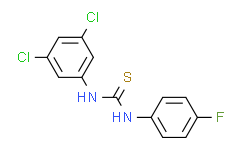| Cas No.: | 790-69-2 |
| Chemical Name: | loflucarban |
| Synonyms: | Thiourea,N-(3,5-dichlorophenyl)-N'-(4-fluorophenyl)-;1-(3,5-dichlorophenyl)-3-(4-fluorophenyl)thiourea;3,5-Dichloro-4'-fluorothiocarbanilide;Fluonilid;Fluonilide;Fluoro-4-dichloro-3',5'-thiocarbanilide;Loflucarban;Loflucarbanum;Loflucarbanum [Latin] |
| SMILES: | FC1=CC=C(NC(NC2=CC(Cl)=CC(Cl)=C2)=S)C=C1 |
| Formula: | C13N2FScl2H9 |
| M.Wt: | 315.1934 |
| Purity: | >98% |
| Sotrage: | 2 years -20°C Powder, 2 weeks 4°C in DMSO, 6 months -80°C in DMSO |
| Description: | Loflucarban (Fluonilid) is a potent antimycotic agent. Loflucarban can be used for the research of the ear infections[1]. |
| In Vitro: | One hundred-and-eighty-six fungi were isolated from one hundred-and-eighty cases diagnosed as otomycosis. They comprise 59 species of 26 genera of moulds, and 2 genera of yeasts. Fluonilid shows the MIC ranged from > 100 μg/ml to 1 μg/ml for the majority of tested fungi[1]. |
| References: | [1]. Maher A, et al. Otomycosis: an experimental evaluation of six antimycotic agents. J Laryngol Otol. 1982;96(3):205-213. |

 DC Chemicals' products qualify for U.S. tariff exemptions. We guarantee no price increases due to customs duties and maintain stable supply, continuing to deliver reliable research solutions to our American clients.
DC Chemicals' products qualify for U.S. tariff exemptions. We guarantee no price increases due to customs duties and maintain stable supply, continuing to deliver reliable research solutions to our American clients.





















